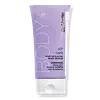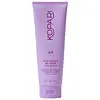What's inside
What's inside
 Key Ingredients
Key Ingredients

 Benefits
Benefits

 Concerns
Concerns

 Ingredients Side-by-side
Ingredients Side-by-side

Water
Skin ConditioningAlumina
AbrasiveAloe Barbadensis Leaf Juice
Skin ConditioningSilica
AbrasiveGlycerin
HumectantCaprylic/Capric Triglyceride
MaskingCetearyl Alcohol
EmollientHelianthus Annuus Seed Oil
EmollientCocos Nucifera Oil
MaskingStearyl Alcohol
EmollientMicrocrystalline Cellulose
AbsorbentPropanediol
SolventBetaine
HumectantCellulose
AbsorbentSodium Methyl Cocoyl Taurate
CleansingLactobacillus/Punica Granatum Fruit Ferment Extract
Skin ConditioningLactic Acid
BufferingSodium Hyaluronate
HumectantLeuconostoc/Radish Root Ferment Filtrate
AntimicrobialOryza Sativa Bran Extract
Skin ConditioningHelianthus Annuus Extract
EmollientRosmarinus Officinalis Leaf Extract
AntimicrobialHelianthus Annuus Seed Wax
Skin ConditioningSimmondsia Chinensis Seed Oil
EmollientTrisodium Ethylenediamine Disuccinate
Myristyl Nicotinate
Skin ConditioningOryza Sativa Hull Powder
AbrasiveCetearyl Glucoside
EmulsifyingDehydroxanthan Gum
Emulsion StabilisingTocopherol
AntioxidantGlucose
HumectantEthylhexylglycerin
Skin ConditioningParfum
MaskingCitric Acid
BufferingSodium Benzoate
MaskingSodium Hydroxide
BufferingPotassium Sorbate
PreservativeBenzyl Salicylate
PerfumingGeraniol
PerfumingLinalool
PerfumingWater, Alumina, Aloe Barbadensis Leaf Juice, Silica, Glycerin, Caprylic/Capric Triglyceride, Cetearyl Alcohol, Helianthus Annuus Seed Oil, Cocos Nucifera Oil, Stearyl Alcohol, Microcrystalline Cellulose, Propanediol, Betaine, Cellulose, Sodium Methyl Cocoyl Taurate, Lactobacillus/Punica Granatum Fruit Ferment Extract, Lactic Acid, Sodium Hyaluronate, Leuconostoc/Radish Root Ferment Filtrate, Oryza Sativa Bran Extract, Helianthus Annuus Extract, Rosmarinus Officinalis Leaf Extract, Helianthus Annuus Seed Wax, Simmondsia Chinensis Seed Oil, Trisodium Ethylenediamine Disuccinate, Myristyl Nicotinate, Oryza Sativa Hull Powder, Cetearyl Glucoside, Dehydroxanthan Gum, Tocopherol, Glucose, Ethylhexylglycerin, Parfum, Citric Acid, Sodium Benzoate, Sodium Hydroxide, Potassium Sorbate, Benzyl Salicylate, Geraniol, Linalool
Water
Skin ConditioningPumice
AbrasiveGlycerin
HumectantLactic Acid
BufferingGlycolic Acid
BufferingCaprylic/Capric Triglyceride
MaskingHydroxypropyl Starch Phosphate
Stearic Acid
CleansingCetearyl Alcohol
EmollientSorbitan Oleate Decylglucoside Crosspolymer
CleansingSodium Lauroyl Sarcosinate
CleansingSodium Hydroxide
BufferingCocos Nucifera Shell Powder
AbrasiveVolcanic Sand
Skin ConditioningAvena Sativa Kernel Extract
AbrasiveSalix Nigra Bark Extract
Skin ProtectingCamellia Sinensis Leaf Extract
AntimicrobialSimmondsia Chinensis Seed Oil
EmollientLactobacillus Ferment
Skin ConditioningGlycyrrhiza Glabra Root Extract
BleachingSorbitol
HumectantDecyl Glucoside
CleansingHydroxyethylcellulose
Emulsion StabilisingLauryl Glucoside
CleansingGlyceryl Stearate
EmollientSodium Methyl Cocoyl Taurate
CleansingSodium Stearoyl Lactylate
EmulsifyingPotassium Sorbate
PreservativeSodium Benzoate
MaskingPhenoxyethanol
PreservativeWater, Pumice, Glycerin, Lactic Acid, Glycolic Acid, Caprylic/Capric Triglyceride, Hydroxypropyl Starch Phosphate, Stearic Acid, Cetearyl Alcohol, Sorbitan Oleate Decylglucoside Crosspolymer, Sodium Lauroyl Sarcosinate, Sodium Hydroxide, Cocos Nucifera Shell Powder, Volcanic Sand, Avena Sativa Kernel Extract, Salix Nigra Bark Extract, Camellia Sinensis Leaf Extract, Simmondsia Chinensis Seed Oil, Lactobacillus Ferment, Glycyrrhiza Glabra Root Extract, Sorbitol, Decyl Glucoside, Hydroxyethylcellulose, Lauryl Glucoside, Glyceryl Stearate, Sodium Methyl Cocoyl Taurate, Sodium Stearoyl Lactylate, Potassium Sorbate, Sodium Benzoate, Phenoxyethanol
Ingredients Explained
These ingredients are found in both products.
Ingredients higher up in an ingredient list are typically present in a larger amount.
This ingredient is an emollient, solvent, and texture enhancer. It is considered a skin-softener by helping the skin prevent moisture loss.
It helps thicken a product's formula and makes it easier to spread by dissolving clumping compounds.
Caprylic Triglyceride is made by combining glycerin with coconut oil, forming a clear liquid.
While there is an assumption Caprylic Triglyceride can clog pores due to it being derived from coconut oil, there is no research supporting this.
Learn more about Caprylic/Capric TriglycerideCetearyl alcohol is a mixture of two fatty alcohols: cetyl alcohol and stearyl alcohol. It is mainly used as an emulsifier. Emulsifiers help prevent the separation of oils and products. Due to its composition, it can also be used to thicken a product or help create foam.
Cetearyl alcohol is an emollient. Emollients help soothe and hydrate the skin by trapping moisture.
Studies show Cetearyl alcohol is non-toxic and non-irritating. The FDA allows products labeled "alcohol-free" to have fatty alcohols.
This ingredient is usually derived from plant oils such as palm, vegetable, or coconut oils. There is debate on whether this ingredient will cause acne.
Due to the fatty acid base, this ingredient may not be Malassezia folliculitis safe.
Learn more about Cetearyl AlcoholGlycerin is already naturally found in your skin. It helps moisturize and protect your skin.
A study from 2016 found glycerin to be more effective as a humectant than AHAs and hyaluronic acid.
As a humectant, it helps the skin stay hydrated by pulling moisture to your skin. The low molecular weight of glycerin allows it to pull moisture into the deeper layers of your skin.
Hydrated skin improves your skin barrier; Your skin barrier helps protect against irritants and bacteria.
Glycerin has also been found to have antimicrobial and antiviral properties. Due to these properties, glycerin is often used in wound and burn treatments.
In cosmetics, glycerin is usually derived from plants such as soybean or palm. However, it can also be sourced from animals, such as tallow or animal fat.
This ingredient is organic, colorless, odorless, and non-toxic.
Glycerin is the name for this ingredient in American English. British English uses Glycerol/Glycerine.
Learn more about GlycerinLactic Acid is another well-loved alpha hydroxy acid (AHA). It is gentler than glycolic acid but still highly effective.
Its main role is to exfoliate the surface of the skin by loosening the “glue” that holds dead skin cells together. Shedding those old cells leads to smoother, softer, and more even-toned skin.
Because lactic acid molecules are larger than glycolic acid, they don’t penetrate as deeply. This means they’re less likely to sting or irritate, making it a great choice for beginners or those with sensitive skin.
Like glycolic acid, it can:
Lactic acid also acts as a humectant (like hyaluronic acid). It can draw water into the skin to improve hydration and also plays a role in the skin's natural moisturizing factor (NMF) in the form of sodium lactate.
Studies show it can boost ceramide production to strengthen the skin barrier and even help balance the skin’s microbiome.
To get results, choose products with a pH between 3-4.
Lower strengths (5-12%) focus on surface exfoliation; higher strengths (12% and up) can reach deeper in the dermis (deeper, supportive layer) to improve skin texture and firmness over time.
Though it was originally derived from milk, most modern lactic acid used in skincare is vegan. It is made through non-dairy fermentation to create a bio-identical and stable form suitable for all formulations.
When lactic acid shows up near the end of an ingredient list, it usually means the brand added just a tiny amount to adjust the product’s pH.
Legend has it that Cleopatra used to bathe in sour milk to help reduce wrinkles.
Lactic acid is truly a gentle multitasker: it exfoliates, hydrates, strengthens, and brightens. It's a great ingredient for giving your skin a smooth, glowing, and healthy look without the harshness of stronger acids.
Read more about some other popular AHA's here:
Learn more about Lactic AcidPotassium Sorbate is a preservative used to prevent yeast and mold in products. It is commonly found in both cosmetic and food products.
This ingredient comes from potassium salt derived from sorbic acid. Sorbic acid is a natural antibiotic and effective against fungus.
Both potassium sorbate and sorbic acid can be found in baked goods, cheeses, dried meats, dried fruit, ice cream, pickles, wine, yogurt, and more.
You'll often find this ingredient used with other preservatives.
Learn more about Potassium SorbateThis oil comes from the seeds of the desert shrub called Jojoba. It is more commonly known as jojoba oil, a non-comedogenic oil.
Jojoba oil does not contain fragrance and has many fatty-acids, making it a great soothing ingredient.
It also contains Vitamin E, a great moisturizing ingredient. Vitamin E is also an antioxidant and protects your skin against oxidative damage.
This ingredient humectant properties, meaning it helps draw moisture from the air. This helps keep your skin hydrated.
While jojoba has antibacterial properties, it is only able to kill some strains of bacteria.
Studies also show it helps in wound healing. In fact, Indigenous cultures have used jojoba as a moisturizer and to help treat burns for centuries.
Fun fact: Jojoba oil similar to natural human skin sebum, so it has a great effect on dry skin. It is also promising with helping to regulate sebum production.
Due to its fatty acid content, Jojoba oil may not be fungal acne safe. We recommend speaking with a professional if you have any concerns.
Learn more about Simmondsia Chinensis Seed OilSodium Benzoate is a preservative. It's used in both cosmetic and food products to inhibit the growth of mold and bacteria. It is typically produced synthetically.
Both the US FDA and EU Health Committee have approved the use of sodium benzoate. In the US, levels of 0.1% (of the total product) are allowed.
Sodium benzoate works as a preservative by inhibiting the growth of bacteria inside of cells. It prevents the cell from fermenting a type of sugar using an enzyme called phosphofructokinase.
It is the salt of benzoic acid. Foods containing sodium benzoate include soda, salad dressings, condiments, fruit juices, wines, and snack foods.
Studies for using ascorbic acid and sodium benzoate in cosmetics are lacking, especially in skincare routines with multiple steps.
We always recommend speaking with a professional, such as a dermatologist, if you have any concerns.
Learn more about Sodium BenzoateSodium Hydroxide is also known as lye or caustic soda. It is used to adjust the pH of products; many ingredients require a specific pH to be effective.
In small amounts, sodium hydroxide is considered safe to use. However, large amounts may cause chemical burns due to its high alkaline.
Your skin has a natural pH and acid mantle. This acid mantle helps prevent harmful bacteria from breaking through. The acid mantle also helps keep your skin hydrated.
"Alkaline" refers to a high pH level. A low pH level would be considered acidic.
Learn more about Sodium HydroxideThis gentle cleansing and foaming ingredient is known for leaving a smooth feeling in skin and hair. It is made using coconut oil.
According to the manufacturer, it is soluble in water and has resistance to hard water, acid, and alkali.
Due to its coconut base, it may not be Malassezia folliculitis safe.
Learn more about Sodium Methyl Cocoyl TaurateWater. It's the most common cosmetic ingredient of all. You'll usually see it at the top of ingredient lists, meaning that it makes up the largest part of the product.
So why is it so popular? Water most often acts as a solvent - this means that it helps dissolve other ingredients into the formulation.
You'll also recognize water as that liquid we all need to stay alive. If you see this, drink a glass of water. Stay hydrated!
Learn more about Water